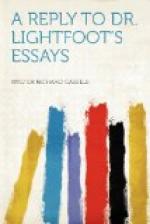III.
POLYCARP OF SMYRNA.
In my chapter on Polycarp I state the various opinions expressed by critics regarding the authenticity of the Epistle ascribed to him, and I more particularly point out the reasons which have led many to decide that it is either spurious or interpolated.
That an Epistle of Polycarp did really exist at one time no one doubts, but the proof that the Epistle which is now extant was the actual Epistle written by Polycarp is not proven. Dr. Lightfoot’s essay of course assumes the authenticity, and seeks to establish it. A large part of it is directed to the date which must be assigned to it on that supposition, and recent researches seem to establish that the martyrdom of Polycarp must be set some two years earlier than was formerly believed. The Chronicon of Eusebius dates his death A.D. 166 or 167, and he is said to have been martyred during the proconsulship of Statius Quadratus. M. Waddington, in examining the proconsular annals of Asia Minor, with the assistance of newly-discovered inscriptions, has decided that Statius Quadratus was proconsul in A.D. 154-155, and if Polycarp was martyred during his proconsulship it would follow that his death must have taken place in one of those years.
Having said so much in support of the authenticity of the Epistle of Polycarp, and the earlier date to be assigned to it, it might have been expected that Dr. Lightfoot would have proceeded to show what bearing the epistle has upon the evidence for the existence of the Gospels and their sufficiency as testimony for the miracles which those Gospels record. He has not done so, however, for he is in such haste to find small faults with my statements, and disparage my work, that, having arrived at this point, he at once rushes off upon this side issue, and does not say one word that I can discover regarding any supposed use of Gospels in the Epistle. For a complete discussion of analogies which other apologists have pointed out I must refer to Supernatural Religion itself; [116:1] but I may here state the case in the strongest form for them. It is asserted that Polycarp in this Epistle uses expressions which correspond more or less closely with some of those in our Gospels. It is not in the least pretended that the Gospels are referred to by name, or that any information is given regarding their authorship or composition. If, therefore, the use of the Gospels could be established, and the absolute authenticity of the Epistle, what could this do towards proving the actual performance of miracles or the reality of Divine Revelation? The mere existence of anonymous Gospels would be indicated, and though this might be considered a good deal in the actual evidential destitution, it would leave the chief difficulty quite untouched.
IV.
PAPIAS OF HIERAPOLIS.




